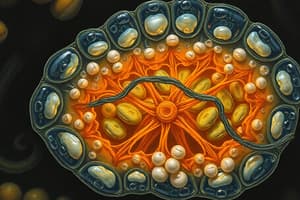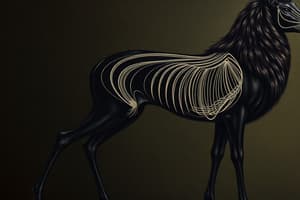Podcast
Questions and Answers
What is an animal?
What is an animal?
Animals are eukaryotic and multicellular organisms that are heterotrophic and motile during at least part of their life cycle.
All animals are sessile during their entire life cycle.
All animals are sessile during their entire life cycle.
False (B)
What is the unique stage in embryonic development that allows cells to differentiate into specialized tissues and organs?
What is the unique stage in embryonic development that allows cells to differentiate into specialized tissues and organs?
- Blastula (correct)
- Blastocoel
- Zygote
- Morula
Which of the following is NOT a characteristic of animals?
Which of the following is NOT a characteristic of animals?
Which kingdom do animals belong to?
Which kingdom do animals belong to?
The vertebrate ________ according to Richard Owen is an ancient trait that influences body shape.
The vertebrate ________ according to Richard Owen is an ancient trait that influences body shape.
Match the following concepts with their definitions:
Match the following concepts with their definitions:
What defines an animal?
What defines an animal?
Which of the following statements about animals is true? (Select all that apply)
Which of the following statements about animals is true? (Select all that apply)
Animals are primarily ________ during at least part of their life cycle.
Animals are primarily ________ during at least part of their life cycle.
Animals do not possess a nucleus in their cells.
Animals do not possess a nucleus in their cells.
What is an archetype in biology?
What is an archetype in biology?
Match the following groups with their characteristics:
Match the following groups with their characteristics:
Flashcards are hidden until you start studying
Study Notes
Animal Architecture Overview
- Animal architecture encompasses principles and features defining the structure and complexity of animals.
- Key areas include animal complexity, symmetry, embryonic development, and architectural patterns which also relate to body size.
Characteristics of Animals
- Animals are eukaryotic and multicellular organisms, distinguished from plants and algae which are autotrophic.
- They are heterotrophic, relying on organic material for nutrition, and most exhibit aerobic respiration.
- All animals experience motility in part of their life cycle; some become sessile later in life.
Developmental Stages
- The blastula stage is unique to animals, marking the beginning of specialized tissue and organ formation during embryonic development.
- Early developmental structures include the blastocoel, which plays a critical role in the formation of body plans.
Taxonomical Context
- Animals belong to the kingdom Animalia, which is distinct from kingdoms like Plantae, Fungi, Monera, and Protista based on various cellular and nutritional criteria.
- The presence of a nucleus, multicellularity, heterotrophic nature, aerobic respiration, motility, and the formation of a blastula are key distinguishing features.
Phylogenetic Classification
- The evolutionary history of animals can be visualized through phylogenetic trees, which classify life forms based on shared characteristics.
- In modern classifications, animalia is typically placed below Protista and Fungi in the evolutionary hierarchy.
Archetype in Biology
- Archetype refers to the ideal body plan or pattern from which other forms are derived; it plays a significant role in anatomical evolution.
- Once established, an archetype imposes structural and functional limitations on its evolutionary successors, as seen in lineages such as mollusks and fish.
Eumetazoa vs. Parazoa
- Animals are divided into two major groupings: Eumetazoa (true animals with organized tissues) and Parazoa (represented by sponges).
- Parazoa encompasses simpler life forms that lack organized tissues.
- Eumetazoa includes all metazoans except for sponges and placozoans, reflecting more complex body structures.
Animal Architecture Overview
- Animal architecture encompasses principles and features defining the structure and complexity of animals.
- Key areas include animal complexity, symmetry, embryonic development, and architectural patterns which also relate to body size.
Characteristics of Animals
- Animals are eukaryotic and multicellular organisms, distinguished from plants and algae which are autotrophic.
- They are heterotrophic, relying on organic material for nutrition, and most exhibit aerobic respiration.
- All animals experience motility in part of their life cycle; some become sessile later in life.
Developmental Stages
- The blastula stage is unique to animals, marking the beginning of specialized tissue and organ formation during embryonic development.
- Early developmental structures include the blastocoel, which plays a critical role in the formation of body plans.
Taxonomical Context
- Animals belong to the kingdom Animalia, which is distinct from kingdoms like Plantae, Fungi, Monera, and Protista based on various cellular and nutritional criteria.
- The presence of a nucleus, multicellularity, heterotrophic nature, aerobic respiration, motility, and the formation of a blastula are key distinguishing features.
Phylogenetic Classification
- The evolutionary history of animals can be visualized through phylogenetic trees, which classify life forms based on shared characteristics.
- In modern classifications, animalia is typically placed below Protista and Fungi in the evolutionary hierarchy.
Archetype in Biology
- Archetype refers to the ideal body plan or pattern from which other forms are derived; it plays a significant role in anatomical evolution.
- Once established, an archetype imposes structural and functional limitations on its evolutionary successors, as seen in lineages such as mollusks and fish.
Eumetazoa vs. Parazoa
- Animals are divided into two major groupings: Eumetazoa (true animals with organized tissues) and Parazoa (represented by sponges).
- Parazoa encompasses simpler life forms that lack organized tissues.
- Eumetazoa includes all metazoans except for sponges and placozoans, reflecting more complex body structures.
Studying That Suits You
Use AI to generate personalized quizzes and flashcards to suit your learning preferences.




